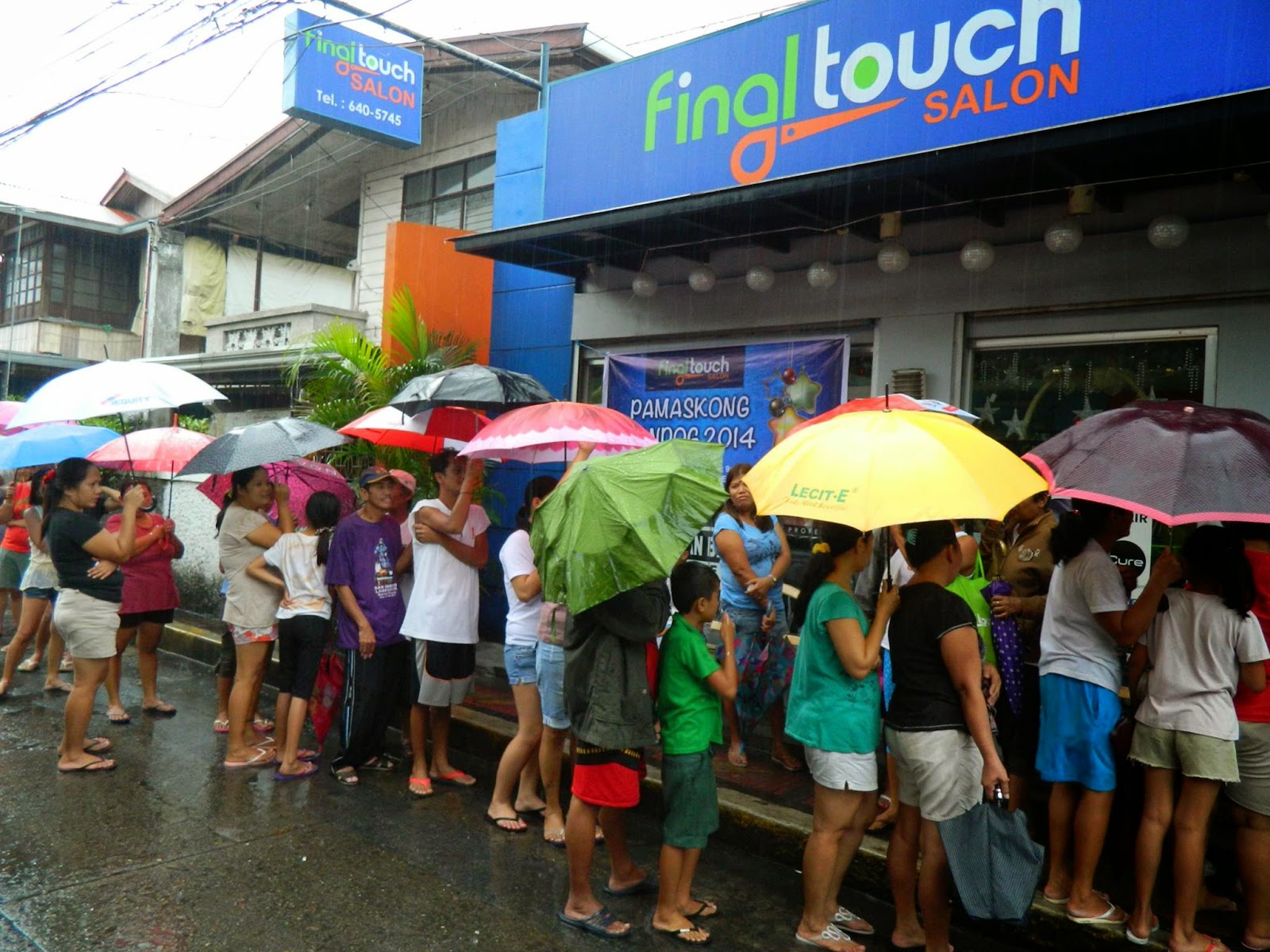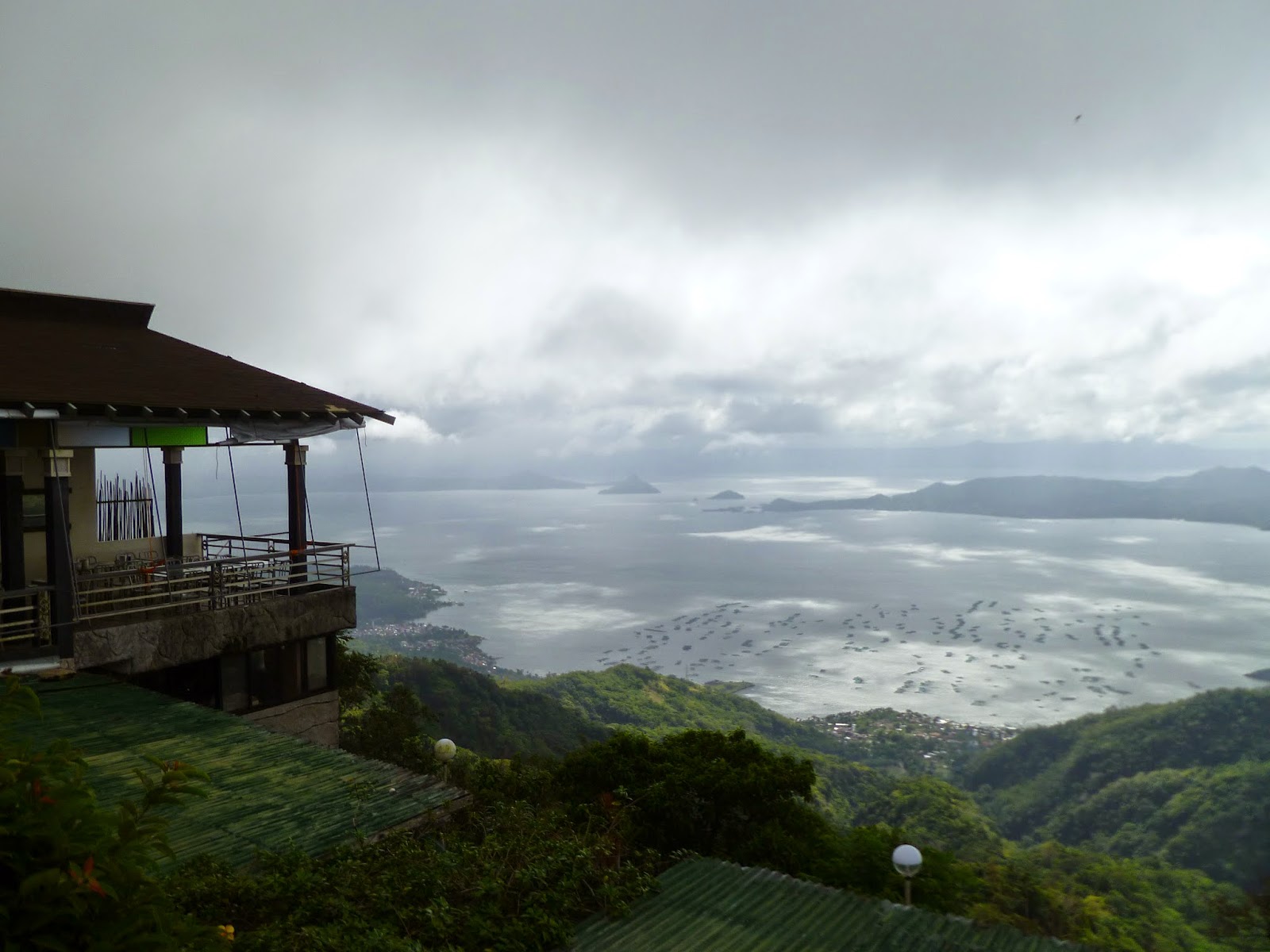Day 3: December 24, 2014 - Final Touch Salon Giveaway and Brazilian blowout on Christmas Eve
Weeks before I arrived in the Philippines, I had arranged with one of my cousins to make an appointment to get my hair straightened. One of the awesome aspects of going to the Philippines is a lot of personal care services are so much cheaper than in the States. So of course I had to take advantage of it.
 |
| The giveaway bags full of groceries |
My uncle's assistant, Lhita, made the appointment for me at a hair salon just a couple of blocks away from our house. My appointment was for 9 am when the shop opened so, being used to punctuality, Lhita, my sister and my niece who were going to get their hair cut, and I arrived a few minutes before 9. My stylist hadn't arrived yet and a call placed to him assured us he was "on his way". On his way translated into being almost an hour late. That is one aspect of Filipino habits I don't embrace. Tardiness has become one of my pet peeves as it shows such a lack of respect for one's time while the tardy person goes on their own schedule. But if there's anything I've learned in all my travels is that it's often best to leave your home-country preferences at home and to "go with the flow" on certain things. Punctuality being one of them when dealing with a more laidback culture.
 |
| Employees of Final Touch salon |

Waiting actually worked out because it turns out that when we were there on Christmas Eve day, the salon, Final Touch, was doing a "giveaway". Giveaway doesn't have the American meaning of some kind of freebie of "buy one get one free" or sample sizes of a product promotion happening in a store. This giveaway was more akin to churches giving out bags of groceries to the needy except this was a local business doing the giving. My cousin Albert, who is a town councilor and often does charitable works for the poor, identified those in the area with the most need and each family was given a ticket. Final Touch Salon's owners (who turned out to be distant relations on my dad's side) spent their own personal money to buy rice, groceries and vitamins enough to fill 200 bags. Each family with a ticket could come to Final Touch on Christmas Eve and receive a bag of groceries. Final Touch's employees helped portion out all of the groceries into the bags the day before then they helped with passing out the bags on Christmas Eve when the salon opened.

The experience touched me on several different levels. For one, it was heartbreaking to see such need. People lined up long before the salon opened, clutching their tickets, despite the pouring rain at the time. Some brought extra family members in hopes of getting an extra bag and the salon owners had to politely but firmly explain it was only 1 ticket per family and 1 ticket per bag. Others had heard about the giveaway and shown up hopefully, young children in tow, and had to be regretfully turned away because they didn't have a ticket as the salon had to make sure they had enough bags for all of the tickets given out. Part of me almost felt despair at the overwhelming need, wondering how long a sack of groceries could sustain a large family. One day? Two? And that was for the lucky ones who were able to get a bag in the first place.

But as one of my aunts always tells me, "It may just be a drop in the bucket, but that's still better than an empty bucket." And that's something I always have to remember. Perfection is the enemy of progress. Just because you can't feed them all every day doesn't mean you shouldn't try to feed some for at least a day. Many of the people lined up had jobs but they still struggle to make ends meet and feed their families. A helping hand (or a full grocery bag) matters a lot in their struggles.

What struck me the most was the attitude of generosity. In the US, there's been a sentiment of considering many helping hand outreaches as "socialism" or villefying the poor as being "too lazy to work" and of "sponging off of the government". I've heard people talk about how hard they've worked for what they have and why shouldn't others do the same, how they themselves were never given any breaks so why should other people expect things to be just handed to them? In the Philippines, the sentiment is a little different. Because much of the country is so poor, there's more a sense of community and of helping each other during hard times. The salon's "giveaway" was regarded as not so much giving food but as giving "blessing". Meaning the owners and those fortunate to work there have much more than those lining up with their tickets and they were sharing those blessings with them. The sentiment has both cultural and religious roots, Biblical in giving to the poor and having it be returned unto you tenfold and cultural in that Filipinos don't believe in being stingy with food else food be stingy with you. Meaning you always should be generous with food and it's believed your generosity will manifest back to you as you will always have food in abundance.
It's an experience I won't forget anytime soon and I was actually glad Rey, my stylist, was late as the waiting time gave me a chance to watch Filipino generosity and sharing of blessings in action. And when Rey arrived, my hair straightening went underway. In the US, the procedure would be considered similar to a Brazilian blowout. In the Philippines, they call it "re-bonding". The process is similar - apply a cement solution to the hair, let set for a time, wash, blow dry and straighten every strand of hair with a flatiron (that part took the longest time as he was very meticulous about getting every strand), apply another solution and let it set, wash again, this time with a hot oil treatment, then a final blow dry. Result is my hair went from strongly wavy and freaking frizzy in tropical humidity to stick straight Asian hair I wasn't lucky enough to be born with but could at least buy for a time from the salon. Best part? At home, a Brazilian would cost me $250-$300 or more. In the Philippines - $50 plus tips for Rey and Jamie, the shampoo girl. Totally worth the trip.
 |
| Before and after pics of my Brazilian blowout |
Despite the late start, I was done in time to join my family to a trip to my aunt's house in Fort Bonifacio where she hosted us for Christmas Eve dinner. There were 14 of us but she made enough for 50 so it didn't look like we made much of a dent. It was a far cry from the scenes from that morning and forcibly reminded me just how blessed I am.


















































